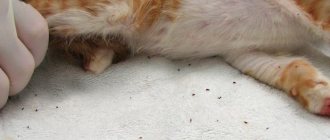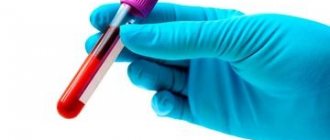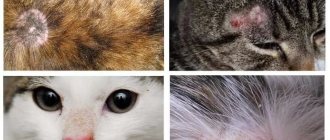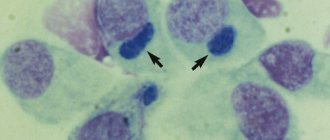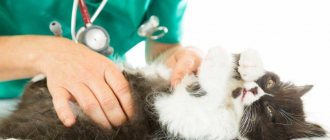A cat has elevated leukocytes in the blood: causes and treatment
When animals become ill, the examination almost always begins with a blood test. And if a cat has elevated leukocytes in the blood, this is a sign of an inflammatory process in the body. Leukocytes are called nuclear-free blood cells that have no color. Their main function is to fight foreign elements and destroy waste products, so the number of white blood cells in the blood serves as a kind of indicator of inflammation caused by allergies, infection or some kind of disease.
Other reasons
Oddly enough, but by the characteristics and number of leukocytes one can judge not only the presence or absence of infectious pathologies. So, there is the concept of “toxic neutrophilia”. We are talking about a sharp increase in the content of immature forms of neutrophils. This is very typical for many forms of poisoning, including chronic ones.
There are also more specific cases. For example, Chediak-Higashi syndrome. A fairly rare hereditary disease found in Persian cats. It is accompanied by an increased tendency to bleeding with or without cause, a change in the color of the iris, as well as a large number of basophils and eosinophils in the blood.
The Pelger-Huet anomaly also belongs to this group. A hereditary, genetically determined disease, characterized by the accumulation of nuclear chromatin in the cytoplasm of the same long-suffering neutrophils. This disorder was initially identified in rabbits, but scientists later found that the disease can occur in cats, dogs and humans.
{amp}gt;The cat’s leukocytes are low or high. Characteristic symptoms
Types of leukocytes, leukogram
The norm for cats is considered to be a leukocyte content within the range of 5.5•10 3 ÷ 18.5•10 3 units/l. Leukocytosis (the content of these blood elements exceeding the norm) can be due to dozens or even hundreds of reasons. Leukocytosis can be caused by physiological factors - stress, pain, pregnancy. In this case, the abnormal blood count does not persist for a long time. But if a repeated blood test shows a leukocyte level that exceeds the permissible norm, the veterinarian sends the cat for a full examination using laboratory and hardware methods.
There are several types of white blood cells, their percentage is called the leukocyte formula or leukogram. Previously, the counting of each type of leukocyte was carried out visually: a dried and stained blood smear was placed under a microscope and the number of cells in the field of view was counted. Today, a leukogram is obtained using a special analyzer device, which in a few minutes calculates the ESR and leukocyte formula with great accuracy.
The following indicators are considered acceptable:
The role of the element in the body
Reasons for the increase in quantity
recognize and destroy foreign proteins
blood diseases, the presence of viral and bacterial infections (including hidden ones), chronic inflammatory diseases
phagocytose about antibodies.
oncology, infections, early postoperative period
absorb and utilize the antigen-antibody complex
allergic reactions, atopic diseases, long-term use of antibiotics, helminthiasis
provide blood clotting processes
pregnancy, bleeding, period after recent surgery, taking corticosteroids
destroy foreign protein elements, toxin molecules
hereditary diseases Pelger-Huet anomaly and Chediak-Higashi syndrome, poisoning, acute infectious process, course of steroids
form an inflammatory reaction, releasing heparin, serotonin, histamine,
severe purulent infections, allergic reactions, inflammatory diseases of the gastrointestinal tract, liver, kidneys, endocrine disorders
If an excess of the total level of leukocytes is called leukocytosis, then an excess of the norm for individual types is called granulocytosis, lymphocytosis, thrombocytosis, monocytosis, etc.
Good to know. A person cannot become infected with leukocytosis from a cat. But since some diseases are common to humans and animals, the disease that caused leukocytosis in the cat may be dangerous.
How leukocytes can change and the reasons for this phenomenon
An increase in white blood cells is usually accompanied by inflammatory reactions and an infectious process. In this case, young cellular forms predominate. A decrease in the number of leukocytes can be associated with the use of a number of medications, radiation exposure, and shock. In some infections, the white blood cell count may be low. Moreover, various types of pathologies are characterized by changes in one form or another of leukocytes.
Lymphocytes
These formed elements take an active part in the recognition and rejection of foreign proteins. They also participate in the processes of humoral immunity and are cytotoxic to cancer cells and cells affected by viruses.
An increase in the level of lymphocytes (lymphocytosis) signals lymphocytic leukemia or the penetration of toxoplasma into the animal’s body, or a number of viral infections.
A decrease in the level of these elements (leukopenia) is observed in immunodeficiency states, liver pathology and kidney disease, with long-term therapy with corticosteroids, circulatory failure and chronic pulmonary pathology.
Neutrophils
The main purpose of these formed elements is to destroy pathogens, foreign particles and proteins that have entered the animal’s body.
Exceeding the norm of these elements (neutrophilia) indicates an infectious process in the cat’s body, poisoning, cancer, or long-term use of antihistamines or steroid drugs.
A decrease in the number of neutrophils (neutropenia) indicates bone marrow pathology and impaired immunity, some bacterial and fungal infections, and some types of anemia. A decrease in these elements is observed with long-term use of certain antimycotic drugs and radiation therapy.
A neutrophilic shift to the left (the appearance of a larger number of band elements) indicates a decrease in the overall reactivity of the animal’s body. A right shift in the leukogram (a decrease in the number of band elements and an increase in the number of segments) may be evidence of certain types of anemia, kidney pathology and liver disease.
Eosinophils
They have phagocytic activity, but this quality is demonstrated mainly when participating in an allergic reaction. They absorb and digest the antigen-antibody complex formed by immunoglobulin E.
Eosinophilia or an increase in the number of these elements is observed in bronchial asthma, various types of allergic reactions, helminthiasis, in infectious diseases at the recovery stage, and long-term antibiotic therapy.
Eosinopenia or a decrease in the number of eosinophils in the blood is detected in acute infections, burns, injuries, stressful situations, in elderly animals, on the 1st day after a heart attack, in the early postoperative period.
Basophils
They are directly involved in the inflammatory and allergic reactions of the cat’s body.
Basophils are found in the blood of an animal during allergic reactions, leukemia, ulcerative processes or chronic inflammation in the intestines, acute inflammation of the liver, and endocrine disorders.
Monocytes
These elements are classified as agranulocytes; they have phagocytic properties and are designed to rid the cat’s body of dying cells, denatured protein, pathogens (bacteria) and antigen-antibody complexes.
Monocytosis occurs in acute infectious diseases, including protozoans, oncology, leukemia, and in the early postoperative period.
Monocytopenia can be diagnosed during sepsis, during childbirth, bone marrow damage, and long-term therapy with hormonal drugs.
Diagnostics
A leukogram greatly narrows the search for the causes of leukocytosis, since it helps to judge the infectious or parasitic nature of the pathology. However, it is impossible to make an accurate diagnosis based on only one leukogram, since an increase in the level of leukocytes in a cat can develop not only as a result of non-infectious processes, but also in many acute and chronic systemic diseases. We should also not forget that increased production of red blood cells often serves as a temporary reaction to a physiological factor.
Therefore, differential diagnosis of the causes of leukocytosis, in addition to collecting anamnesis and a thorough examination of the animal, may include:
- clinical blood test (study of the morphology of formed elements, determination of biochemical composition and physicochemical properties);
- Analysis of urine;
- stool analysis;
- PCR analysis (an ultrasensitive method based on the polymerase chain reaction makes it possible to detect even a small number of infectious pathogens);
- Blood ELISA (enzyme immunoassay allows you to identify fragments of bacteria and viruses, as well as products of their vital activity or decay);
- Ultrasound of internal organs;
- X-ray examination.
Treatment of the underlying disease
Leukocytosis is not a disease, but a symptom. An upward shift in the level of blood cells serves as a signal about the presence of a pathological process in the body. Therefore, it is wrong to talk about treating leukocytosis; the disease that caused it needs to be treated.
If an increase in the level of leukocytes in a cat is caused by physiological factors (pain, stress) or is caused by taking medications, this indicator will normalize on its own after eliminating the provoking cause.
Attention! To destroy an infection or treat a systemic disease, each case requires its own treatment tactics. Therefore, the cat owner should under no circumstances rely on his own strength and capabilities to relieve the symptom of leukocytosis; the appointment can only be made by a qualified veterinarian.
Depending on the type of pathology detected during the examination, the cat may be prescribed:
- Antiviral agents Anandin, Camedon, Neoferon, Fosprenil;
- Antibacterial agents Amoxicillin, Gentamicin, Clamoxil, Engemicin;
- Antihistamines Diazolin, Tavegil, Loratadine, Cetirizine;
- Anti-inflammatory and painkillers Cantaren, Liarsin, Ketofen, Rimadyl, Flexoprofen.
In some diseases, pronounced leukocytosis in a cat is eventually replaced by leukopenia: the body cannot cope with the production of an increased amount of “fighters against strangers”, and the level of leukocytes drops below normal. Therefore, veterinarians often prescribe immunomodulator drugs to cats with leukocytosis that increase the resistance of the immune system - Gamavit, Vetozal, Immunovet, Kinoron, Fosprenil.
source
What does a veterinarian's examination of a cat with panleukopenia show?
An animal can become infected with feline distemper on the street, through contact with another cat that has passed the incubation period.
But it is important for pet owners to know how to recognize a dangerous disease and what the signs of the virus are. Panleukemia can occur in several forms - severe, moderate, mild.
The form is determined by the symptoms, behavior of the animal, and its condition. Signs of plague - vomiting, diarrhea, fever - can be expressed in varying degrees of severity.
- With a mild form, the animal may behave apathetically and eat poorly. Loose stools are also observed. Rarely there is vomiting or abdominal pain. If the cat's illness is mild, he will return to normal in a few days. One can hope that a good appetite will soon be restored and the stool will become normal. But we must not forget that after infection a pet can suffer distemper; it is better to exclude its contact with other cats.
- The disease, which occurs in a moderate form, is more severe stress for the cat’s body. After all, he will now vomit (up to 5 times a day) and suffer from frequent diarrhea. Only after a week can recovery occur if the body does not suffer catastrophically from dehydration.
ATTENTION! The disease is severe in its acute form. At first, the owner of a kitten or adult can only observe the apathetic behavior of the animal. Even to delicious cat delicacies, complete indifference remains. The cat does not drink water and does not make contact with humans. Later, such a characteristic symptom as profuse drooling appears. The temperature is very high, reaching a critical level of 41 degrees.
The animal experiences the acute form of the disease very hard. Feline distemper debilitates the cat's body with high fever and vomiting. The food is not completely digested in the stomach and also comes out with mucus. This condition, complicated by fever, can last for 12-14 hours. Qualified help from a veterinarian is required; it is very difficult to cope with a serious illness on your own, at home.
Only a specialist knows how to treat the disease competently and effectively. Therefore, you need to contact him if your pet shows even the first signs of illness.
We invite you to familiarize yourself with: Kurilian Bobtail cats and male cats
The owner of the cat should be alerted by the appearance of vomiting in the animal, diarrhea, in which the feces have an unusual appearance and come out in the form of a foul-smelling slurry with blood.
Even if the vomiting has stopped, this does not mean that the cat’s condition has improved. She won't drink water, and this (combined with diarrhea) will lead to dangerous dehydration.
You can notice how the behavior of the kitten has changed; it tries to hide in the darkness and does not want to move.
Sometimes cat owners calm down on the second day due to the fact that vomiting and diarrhea occur less frequently. They believe that the cat is on the mend. But if you are careful, you may notice the dangerous presence of blood in the stool.
The pet will get worse and even fall into a coma. You cannot treat a pet’s ailments irresponsibly, even if deceptive signs of improvement appear, it should be shown to a specialist. Accurate diagnosis and tests will show a clear picture of the course of the disease.
A cat carrying the virus may not change in appearance or behavior during the incubation period, which lasts from two to ten days. The signs of the disease are most pronounced when it occurs in an acute form.
Attentive owners notice the cat's indifference to food and drink, frequent bouts of vomiting and diarrhea. With such symptoms, the cat should be taken to the veterinary clinic immediately. Upon examination, the doctor will find dryness of the tongue and skin, gums, and eyes.
Pain in the abdomen also appears; when pressure is applied to it, the animal reacts by screaming or moving. The specialist can see signs of dangerous dehydration of the cat’s body, and pancolemia is confirmed by various diagnostic methods. A blood test for this disease is characterized by a low level of white blood cells.
The acute form of the disease, even if the pet survives, can have serious consequences. One of them is a severe disruption of the cardiovascular system. This is especially dangerous for older animals. There is no need to risk their lives; it is better to entrust diagnosis and treatment to an experienced and qualified specialist.
Oncology
The source of red and white blood cells is the bone marrow. Just like humans, animals can develop tissue malignancies. It affects lymphoma, myeloma and metastases of other types of oncology. If tests show that a cat’s white blood cells are low, he may suffer from one of the pathologies mentioned. The following symptoms also indicate its presence:
increased susceptibility to infections - leukocytes protect the owner from pathogens;
The final diagnosis is made based on the results of a blood test. For oncology, chemotherapy and radiation may be prescribed. If malignant cells are localized (for example, in a limb), doctors sometimes resort to amputation.
Additionally, antibiotics are used to combat panleukopenia with secondary bacterial infections, and painkillers.
Viruses
A change in the number of leukocytes can be provoked by extracellular infectious agents. Thus, bone marrow and other tissues that affect the number of white blood cells are affected by viruses:
Viral infections are currently incurable - veterinarians prescribe maintenance therapy. Its effectiveness depends on the timely initiation of treatment. So, your pet can be vaccinated against distemper, preventing infection.
Having noticed that a cat's white blood cells are low, the owner should immediately consult a veterinarian to clarify the diagnosis. A viral infection will be indicated by:
the pet's desire to hide;
decreased activity and appetite.
These are common symptoms for various conditions. It is always necessary to pay attention to them and consult with a specialist, since symptoms appear in a wide range of pathologies. Identifying any of them at an early stage will allow you to prolong and improve your pet’s life with timely treatment.
Stress
May cause an increase in the concentration of neutrophils, a type of white blood cell. There are also eosinophils, basophils, lymphocytes, granulocytes and monocytes. Stress is characterized by changes in behavior, decreased appetite, reluctance to interact with others and aggression.
If the reason is the emotional state of the cat, you should try to eliminate the irritants or minimize contact with them. So, the owner can start feeding the animal the usual food or start paying the usual amount of attention.
The latter is necessary if the cat has been neglected due to a change in family composition, moving, or the appearance of a new pet.
Inflammatory processes
With them, the cat usually has elevated leukocytes in the blood - the immune system is activated to fight foreign structures. An increase in the concentration of white blood cells in combination with inflammation causes:
- bacterial and fungal infections - leads to additional generation of neutrophils;
allergies to food and external irritants - provoke an increase in the concentration of eosinophils;
autoimmune diseases - characterized by an increase in the concentration of lymphocytes;
The body responds by releasing white blood cells to various stimuli. Allergies are accompanied by salivation and lacrimation, skin irritation and breathing problems.
With hidden injuries and sprains, pain is present, causing the pet to pay increased attention to the affected area. Infections and autoimmune diseases are detected using tests.
Other diseases
There are many reasons why a cat’s white blood cells are low. In addition to those already mentioned, the list includes:
- Parasites. The body may respond by increasing BCT levels to the presence of heartworms and other worms. Their presence is indicated by weight loss, cough, rapid breathing, weakness and vomiting.
Kidney failure. May cause levels of all types of white blood cells to rise without causing other symptoms. If changes are noticed when taking a blood test for other disorders, you should immediately consult your doctor about additional examination. Symptoms of kidney failure do not appear until the condition reaches its final stages, when treatment is no longer effective.
Potassium deficiency. Causes an increase in the number of leukocytes. Accompanied by weight loss, weakness, vomiting and frequent urination. It is treated by introducing the element with food or injections (the choice is made by the veterinarian).
Congenital diseases. In particular, these include Chediak-Higashi syndrome, which affects the nuclei of all types of leukocytes. Persian cats are susceptible to the disease. It increases susceptibility to bacterial infections and bleeding tendency, accompanied by discoloration of the eyes and skin. Another inherited disorder, Pelger-Huet anomaly, is characterized by the failure of granulocytes to mature normally. In most cases, the disease is asymptomatic. But for some cats it is fatal, accompanied by skeletal deformities and increased susceptibility to infections.
Hereditary disorders are characteristic of purebred individuals. If blood tests and other examinations indicate their presence, animals should be excluded from the breeding system.
A deviation in the level of leukocytes from the norm in a cat’s blood may indicate a number of pathologies: from a cold to oncology. Some conditions are potentially fatal without timely treatment, so it is advisable for the owner to pay attention to changes.
Depending on the disease, the veterinarian will suggest treatments that relieve the pathological condition or help prolong the normal life of the cat.
source
Panleukopenia - causes of infection and distribution of the disease
Owners of cats, purebred or outbred, need to know what the symptoms and treatment of panleukopenia in cats are, and measures to prevent this terrible disease.
All cats are susceptible to disease, regardless of age, breed, or habitat. The disease reaches its greatest peak in early spring, when it is widespread. At this time of year, cat owners need to be especially careful not to allow their pets to come into contact with other cats.
Owners of kittens under one year old and cats over 8 years old should be most attentive. Young and elderly people have reduced resistance to infection by the virus.
Who spreads panleukopenia? Not all cats die from the feline distemper virus. Some survive, but they later become a source of infection. The vomit or feces of this animal enters the environment, and the area becomes infected with many viral particles. Subsequently, other cats entering this area are exposed to the virus. If you walk your pet outside, it can contract the disease even without contact with other cats.
ATTENTION! The reasons for the rapid spread of feline distemper may also be due to the fact that virus particles enter the upper respiratory tract during vomiting of a sick animal. As a result, a serious disease can also be transmitted through airborne droplets, which is even more effective for its rapid spread.
You can protect your pet from this terrible disease if you get information about what panleukopenia is and what the symptoms of this disease are. Like other infectious diseases, this one also has three periods - incubation, clinical, final. The virus is incubated for 10 days.
There is a disease the outcome of which even an experienced veterinarian cannot predict. With panleukopenia, leukopenia occurs in cats, which is accompanied by neutropenia. These terrible diseases are interconnected and it is worth taking a closer look at the causes, symptoms and treatment methods.
Looking ahead, it is worth saying that with this disease, leukopenia, and at the first symptoms, you should urgently contact an experienced veterinarian who has already encountered a similar disease and symptoms. Owners conducting diagnostics and treatment risk endangering the life and health of their pet. After all, treatment is selected on the Internet, without taking into account the specifics of the disease and the animal’s body.
Leukopenia in cats is a disease in which the number of leukocytes in the blood decreases to critical limits. And it’s not for nothing that immunity-boosting products are advertised everywhere. It is because of deficiencies in minerals and certain vitamins that deviations from the norm occur and the disease develops.
If we talk about a stable and positive number of leukocytes in the blood, then in cats it is 5.5-18.0 * 109/l. The quantity can be either reduced or increased. If there are a lot of leukocytes, then an inflammatory reaction occurs in the body. It is not very difficult to treat such deviations; a qualified veterinarian will quickly get the cat back on its feet and return the leukocytes to the desired state.
But a low content has a much more negative effect on the body, and the decrease occurs against the background of many unpleasant diseases, the symptoms and treatment of which are specific and depend on each pet individually. This is the difficulty, because diagnosis becomes not so simple. White blood cells decrease during sepsis.
However, leukopenia is a temporary phenomenon that occurs as a background to infection. Cells die and accumulation occurs at the site of infection. The dangerous case is when it would seem that treatment has been undertaken, but the number of leukocytes does not increase, being in a very dangerous range. This often occurs in veterinary practice.
Blood test in cats
A general blood test in cats gives a general idea of the physiological state of the body; the number of formed elements in the blood allows you to see the condition of the body as a whole. In addition, with a general blood test in a cat, it is possible to determine the presence of blood parasites, such as heartworms and hemobartenella. To carry out this test, venous blood is taken from the cat and placed in a special tube with an anticoagulant, which prevents blood clotting and the destruction of blood cells. There are standards that the results of a general blood test must meet, and deviations from this standard may indicate the presence of specific diseases.
So, the general norms for the results of a general blood test in a cat are as follows:
- Hematocrit - from 26 to 48%, an upward deviation indicates cardiac or pulmonary failure and erythremia;
- Hemoglobin - from 80 to 150 g/l, elevated hemoglobin levels may indicate dehydration of the body, some forms of hemoblastosis, for example, erythremia, a reduced level of hemoglobin in the blood of a cat indicates the presence of various types of anemia, possibly due to blood loss;
- Red blood cells - from 5.3 to 10 x 106 / ml, an increased level of red blood cells indicates erythremia, chronic lung diseases, heart failure, an increased diameter of red blood cells indicates dehydration of the body, lower levels also indicate anemia; An increase in the diameter of erythrocytes indicates a deficiency of vitamin B12 and folate deficiency anemia, liver disease; a small diameter indicates a deficiency of iron in the cat’s body and hemolytic anemia.
- Color index – from 0.65 to 0.9;
- ESR – from 0 to 13 mm/h, an increase in ESR means that inflammatory processes have begun in the cat’s body, poisoning or infection is possible, it is also a signal of tumors, invasions, an increase is considered normal after surgery or after injuries;
A biochemical blood test in cats is a very important way to diagnose possible pathological conditions of the animal. This test requires blood serum and provides a picture of enzyme activity in the body. Assessing the activity of enzymes makes it possible to understand which organs of the cat are affected and the degree of damage to a particular organ. In addition to enzyme analysis, during a biochemical blood test in cats, the amount of substrates, fats and electrolytes in the blood serum is examined. When performing a comprehensive analysis of a cat’s health, this stage of analysis is one of the most important.
Blood for analysis is taken on an empty stomach from a vein and placed in a special test tube, which makes it possible to separate the serum. There are certain norms for indicators of the results of biochemical analysis; deviation from these norms in any direction may indicate the presence of diseases in the cat.
The basic norms for indicators in a biochemical blood test are as follows:
- glucose - from 3.3 to 6.3 mmol/l, increased glucose levels are observed with diabetes mellitus, stress, pancreatic necrosis, as well as with hyperthyroidism and hyperadrenocorticism, reduced levels are characteristic of insulin overdose, hypoadrenocorticism and insulinoma;
- protein - from 54 to 77 g/l, increased protein levels are observed in chronic inflammatory diseases, dehydration, autoimmune diseases and some forms of hemoblastosis, decreased protein indicates nephrotic syndrome, pancreatitis, enteritis, heart failure, hypovataminosis, also characteristic of burns, starvation and malignant formations;
- albumin – from 25 to 37 g/l, albumin indicators correlate with protein levels;
- cholesterol – from 1.3 to 3.7 mmol/l, elevated cholesterol levels indicate the presence of hypothyroidism, diabetes mellitus, pancreatitis;
- total bilirubin – from 3 to 12 µmol/l, an enzyme that is not processed by the liver, an increase indicates vitamin B12 hypovitaminosis;
Electrolyte levels must meet the following standards:
- Potassium - from 4.1 to 5.4 mmol/l, elevated readings of this electrolyte indicate dysfunction of the thyroid gland, tumor, periostitis, renal failure, decreased readings are observed during fasting, vitamin D hypovitaminosis, chronic liver failure,
- Sodium – from 143 to 165 mmol/l;
- Calcium – from 2 to 2.7 mmol/l;
- Iron – from 20 to 30 mmol/l;
- Chlorine – from 107 to 122 mmol/l;
- Phosphorus - from 1.1 to 2.3 mmol/l, an increased deviation from the norm indicates hypothyroidism, renal failure, lower levels indicate diabetes mellitus.
source
Blood test in cats: norm, general indicators and interpretation of results
When contacting a local clinic for help, the first procedure that the doctor prescribes is a blood test for cats . Cats also undergo this event without fail and first of all. In this article we will try to talk about the types of blood tests, what they are needed for, how the results obtained are deciphered and what they tell the doctor.
All information in the article is provided for informational purposes only; under no circumstances should you try to diagnose the disease yourself, much less self-medicate, as this may have a detrimental effect on your pet’s health
!
Blood test in cats: rules for donation
Blood test in cats. This event is accompanied by certain recommendations that should be followed to obtain accurate test results.
.
Blood analysis in cats is carried out using special equipment; it is simply impossible to perform this procedure on your own. Our veterinarian offers a service of taking tests at your home with a doctor visiting you. Results of express tests in 15 minutes on site
. This will help you save time, avoid standing in line, and also protect you from the stress that a kitten may experience when transported to the veterinary center!
The table shows the prices of the Ya-vet veterinary center for laboratory tests of the blood of cats:
| Study | Price, rub | Production time |
| Biochemical blood test of cats – 1 indicator | 200 | 1 working day |
| Biochemical blood test for cats - standard profile (12 indicators) | 1500 | 1 working day |
| Urgent biochemical blood test for cats - standard profile (12 indicators) | 2300 | up to 3 hours |
| Biochemical blood test for cats - extended profile (24 indicators) | 2500 | 1 working day |
| Clinical blood test of cats without ESR | 1000 | 1 working day |
| Clinical blood test of cats with ESR | 1350 | 1 working day |
General blood test in cats, meaning and interpretation.
Complete blood count – This event helps doctors find out the levels of blood cells in your pet’s body. This is the most common procedure
, because many diseases in cats are diagnosed only after viewing a general blood test. Below is a diagram that describes the acceptable values for each indicator, and also describes the reasons why they may be overestimated or underestimated.
A diagram of acceptable values and an explanation of why a blood test in cats may show deviations
Scheme 1. Analysis of values
| Index | Acceptable rate | Increased value | Reduced value |
| Hematocrit | 27-49% |
|
|
| Hemoglobin | 79-149 g/l |
|
|
| Red blood cells | 5.4-10*10 12 /l |
|
|
| Color index | 0,64-1,1 |
|
|
| ESR | 0-13 mm/h |
| A zero ESR is a good result; |
| Leukocytes | 5.4-17.9*10 9 /l |
|
|
| Band neutrophils | 0-3,1% |
|
|
| Segmented neutrophils | 35-75% | ||
| Eosinophils | 0-4,1% |
| |
| Basophils | Rarely found |
| |
| Monocytes | 1-4% |
|
|
| Lymphocytes | 19-56% |
|
|
| Platelets | 300-630 *10 9 /l |
|
|
The data in this diagram is presented to familiarize yourself with the values of blood parameters; it is not recommended to draw any conclusions on your own. The doctors at our clinic will decipher your cat’s blood test results, guided by the European standards by which our center operates.
Biochemical blood test in cats, meaning and interpretation.
Each organ in the body of a cat and any living creature functions at the expense of cells, the activity of which is determined by the presence and ratio of certain enzymes and substrates for each organ. Thus, having learned this ratio or quantity, you can find out the condition and performance of a particular organ
. Biochemistry makes it possible to do this.
Below are the names of enzymes and substrates and their roles in the cat's body.
Enzymes and their role in the cat’s blood
The importance of substrates in cat blood
We have looked at enzymes, now let's move on to substrates, the values of which are also necessary when making a diagnosis:
- Total protein - since protein is an integral component of each organ, the functionality and condition of the body as a whole can be determined by the indicators of this substrate.
- Glucose – with its help, carbohydrate metabolism occurs in the body. It is a very important indicator, as it affects the functionality of many organs.
- General bilirubin has a complex pattern of movement throughout the body. Initially, it has the appearance of indirect bilirubin, but after the connection of red blood cells with liver cells it is converted into direct bilirubin and leaves the body.
- Urea is responsible for the normal functioning of the kidneys, through which it is excreted.
- Cholesterol - plays an important role in the analysis of the obtained readings.
Scheme 2. Analysis of values
| Index | Acceptable rate | Increased value | Reduced value |
| ALT | 20-80 units |
| |
| AST | 10-29 units |
| |
| KFC | 149-799 units |
| |
| Alkaline phosphatase | 40-56 units (for adult cats) |
|
|
| Alpha amylase | 579-1599 units |
|
|
| Total protein | 55-78 g/l |
|
|
| Glucose | 3.2-6.2 mmol/l |
|
|
| Total bilirubin | 3.1-12.1 mmol/l |
|
|
| Urea | 5.5-11.9 mmol/l |
|
|
| Creatinine | 56-179 mmol/l |
|
|
| Cholesterol | 2.1-6.1 mmol/l |
|
|
How is leukopenia treated in cats?
In the case of a low white blood cell count, treatment will be much more difficult and lengthy. It will be necessary not only to eliminate the cause of the development of the pathology, but also to take measures to restore the normal level of leukocytes. Therefore, treatment of leukopenia is usually complex.
Depending on the type of disease detected during examination of the cat, the animal may be prescribed:
- For a bacterial infection - antibiotics of the penicillin, tetracycline or cephalosporin group (Amoxicillin or Clamoxil are most often used);
- For viral diseases - drugs Neotim, Neoferon, Camedon, Anandin, Fosprenil, Dostim;
- To neutralize toxins of anaerobic microbes - hyperimmune serums Vitafel, Globulin;
- For pancreatitis - painkillers and antienzyme drugs Aprotinin, Sinulox, Cefazolin;
- To eliminate the gag reflex - Verakol or Cerucal.
To help your cat's body restore normal levels of white blood cells and strengthen its defenses, it is usually prescribed a course of treatment with drugs that stimulate the production of immune cells and increase the resistance of the immune system. The former are called immunostimulants, the latter - immunomodulators. For leukopenia, Gamapren, Gamavit, Vetozal, Immunovet, Salmozan, Globfel, Kinoron are used.
In case of severe dehydration (due to prolonged diarrhea or vomiting), the cat is administered isotonic solutions, thus replenishing the amount of fluid in the body. The animal also receives nutrients (glucose) through intravenous administration. The cat is transferred to normal food after the attacks of vomiting have completely stopped and the gastrointestinal tract has been restored. For several days, the cat's food should be easily digestible, and it should be given to the animal often, but in small portions.
Low white blood cells in cats indicate serious problems with the immune system. These cells are responsible for protecting the body from infections. More often in animals, the analysis shows an increase in white blood cells. This is a sign of an inflammatory process. After treatment, blood counts return to normal. If leukocytes are low, this may indicate more serious problems with the pet’s health that require long-term treatment from a veterinarian.
When and who do blood tests in cats?
For many diseases, blood tests are done throughout treatment to monitor changes in indicators. For example, panleukopenia. With panleukopenia, serious poisoning of the body and damage to other organs occurs, which requires frequent monitoring of tests. There is a vaccine against panleukopenia, it protects the cat’s body.
A blood test in cats is an integral part of diagnosing the disease and the general condition of the body.
.
We have reviewed the most important information about this event. Our veterinary center has the most modern equipment, the presence of which guarantees you high-quality results. Our doctors have extensive experience in conducting any kind of examinations - this speaks of their professionalism, which plays a big role when choosing a veterinary center. We are always happy to help you. Take care of your pets!
If you find an error, please select a piece of text and press Ctrl+Enter.
source
Treatment and prevention of elevated phosphatase in cats
To select the right food for your cat, you should contact your veterinarian.
The prognosis depends on the timeliness of treatment measures. In most cases it is favorable. An indispensable condition for the effectiveness of treatment is proper nutrition.
It is recommended to switch the animal to ready-made food containing all useful vitamins and microelements, properly balanced. It is necessary to limit the activity of a kitten with fractures by placing it in a cage for about two months. It is recommended to use painkillers, injections of calcium preparations, intravenous infusion is acceptable.
To avoid recurrence, you should treat your pet carefully, limiting too active games and being in dangerous places. Feed according to your doctor's recommendations.
